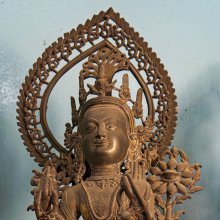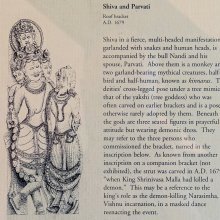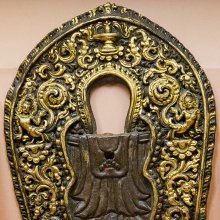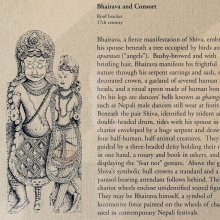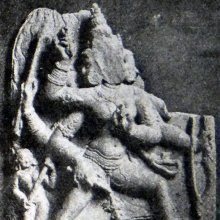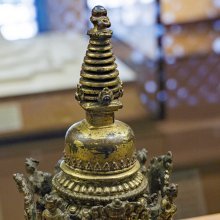Half-human: 1 definition
Introduction:
Half-human means something in Hinduism, Sanskrit. If you want to know the exact meaning, history, etymology or English translation of this term then check out the descriptions on this page. Add your comment or reference to a book if you want to contribute to this summary article.
Images (photo gallery)
In Hinduism
Shilpashastra (iconography)
Source: Shodhganga: Elements of Art and Architecture in the Trtiyakhanda of the Visnudharmottarapurana (shilpa)Half-human forms are associated with Nāgas, which follows specific guidelines in the tradition of ancient Indian Painting (citra), according to the Viṣṇudharmottarapurāṇa, an ancient Sanskrit text which (being encyclopedic in nature) deals with a variety of cultural topics such as arts, architecture, music, grammar and astronomy.—In the Viṣṇudharmottarapurāṇa, the rules of Painting of different classes have been elaborately discussed. The Nāgas are the members of a class of demigods who have the body with half human form and half in serpent’s form. According to the Viṣṇudharmottarapurāṇa, they should have the shape of god and are adorned with snake hood. Thus, it is established that even in the pictures; the people belonging to different class and profession were projected with specific attire [e.g., Nāgas who are half-human] so that general people can equate the picture with the practical character.

Shilpashastra (शिल्पशास्त्र, śilpaśāstra) represents the ancient Indian science (shastra) of creative arts (shilpa) such as sculpture, iconography and painting. Closely related to Vastushastra (architecture), they often share the same literature.
See also (Relevant definitions)
Query error!
Full-text: Arevanisike, Kimpurushi, Aremanisa, Arevanisa, Purushamriga, Serpent, Ashta-manakam, Garuda, Lama, Rupini, Dakini, Patanjali, Snake-hood, Half-serpent, Naga, Khandaroha, Narasimha, Kinnara, Nakar, Parnashavari.
Relevant text
Search found 32 books and stories containing Half-human; (plurals include: humans). You can also click to the full overview containing English textual excerpts. Below are direct links for the most relevant articles:
A Manual of Khshnoom (by Phiroz Nasarvanji Tavaria)
Supplement No. 13 < [Supplements]
Temples of Munnur (Historical Study) (by R. Muthuraman)
Navaratri < [Chapter 6]
The Indian Buddhist Iconography (by Benoytosh Bhattachacharyya)
Ramayana of Valmiki (by Hari Prasad Shastri)
Chapter 88 - Budha encounters Ila < [Book 7 - Uttara-kanda]
Diaspora of Bhuta (Daiva) worshipping cult—India and Indonesia (by Shilpa V. Sonawane)
Part 15 - Science/Physics Connection to Quantum Physics and Ganapati < [Chapter 4 - Inter-Disciplinary Analysis]
Vastu-shastra (Introduction to Indian architecture) (by D. N. Shukla)
Temples of Orissa (3): Koṇārka < [Chapter 12 - History of Hindu Temples (Prāsādas and Vimānas)]
